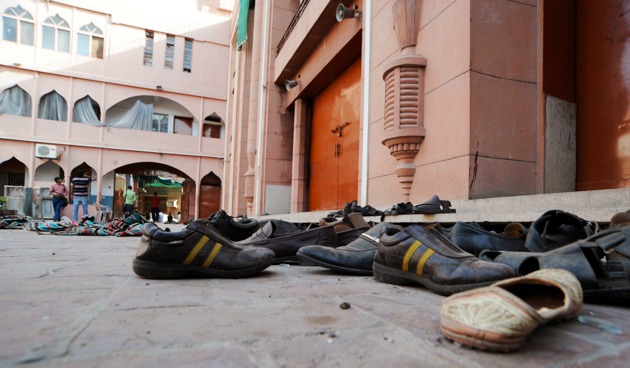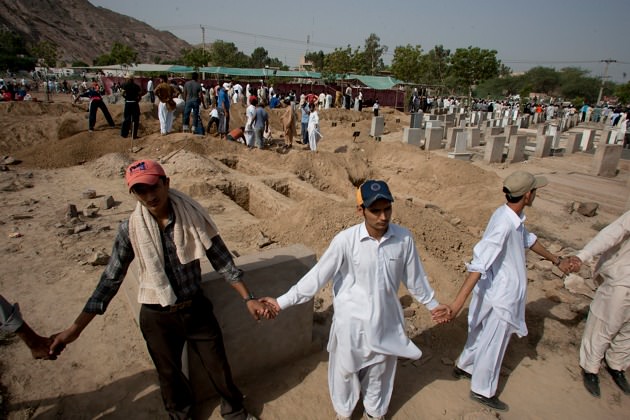The massacre of over 80 worshippers at two mosques in my hometown of Lahore by Pakistani Taliban militants has exposed, in the most extreme and brutal way, the half-heartedness of Pakistan’s military and civilian leadership in confronting homegrown terrorism and the failure of the country’s intelligentsia to recognize the seriousness of the crisis.
At least nine gunmen and suicide bombers shot their way into the two mosques during the weekly Friday prayers on May 28, opening fire on those inside and exploding bombs at random. The worshippers belonged to the Ahmadi sect, just one of several religious groups that the state discriminates against or declines to adequately protect. Other groups include Hindus, Christians and even Shia Muslims. At least 74 people were killed and 108 injured during the attack, but many succumbed to their wounds over the weekend, bringing the death toll to 90, according to Ahmadi officials.
Two of the suicide bombers were captured by worshippers in one of the mosques. One of the two, who was unconscious, was transferred to the prestigious Jinnah Hospital in the center of the city, where he was put under heavy police guard. Then, on the night of May 31, another four terrorists carried out an audacious assault on the hospital in an attempt to free him. They did not succeed but killed four policemen and a female patient before making their escape in a police vehicle.
The Ahmaddiya movement is a sect that follows the teachings of a nineteenth-century religious reformer and promotes the peaceful propagation of a variant of Islam. But in the 1970s, the Pakistani government—under pressure from conservative Muslim clerics—declared the Ahmadis a non-Muslim minority and many Pakistanis today view them as heretics to Islam—something considered far worse than being non-Muslim. Although some two million Ahmadis still live in Pakistan, millions more have fled abroad. Many of the victims at the two mosques—including a retired army Lieutenant General and several retired senior judges and civil servants—were over 70 years old, showing the extent to which the younger generation of Ahmadis have largely left Pakistan.
Ahmadis are by far the most persecuted minority in Pakistan by Islamist parties and right wing media, and they are widely portrayed as subversive and cultish in school text books. Prominent journalists and politicians think nothing of publicly reviling the Ahmadis or Christians, describing them as agents of foreign powers or anti-Pakistan, while the state has again and again demonstrated its unwillingness or inability to protect them and other religious minorities.
Moreover, while Christians have prominent bishops and community leaders who are outspoken about their tribulations, and the Shia priestly hierarchy is influential and is supported outside Pakistan by Iran, nobody is willing to speak up for the Ahmadis. On Friday some of the local TV channels even refused to name their sect, calling them instead “a religious minority.” Senior government officials declined to meet with Ahmadi representatives or visit hospitals where the wounded were being treated.
Pakistan has taken an awfully long time to understand that it faces an unprecedented terrorist threat that is not a result of conspiracies hatched in Washington, New Delhi or Tel-Aviv, as many in the public believe, but that is the result of the Pakistani state’s nurturing of extremist groups since the 1970s.
Part of the problem is the refusal of the army and the government to accept the fact that Pakistan faces a serious terrorist threat in its populated heartland of Punjab. Just a few days before this latest episode, federal ministers, army spokesmen and Punjab province’s Chief Minister Shabaz Sharif heatedly denied the existence of a Punjabi branch of the Taliban, maintaining therefore that no punitive action against Punjabi militants was required. Yet in recent years, Punjabi Taliban been has been responsible for attacking army headquarters, police stations and offices of the Inter-Services Intelligence (ISI).
The Punjabi Taliban are distinct from the Pashtun Taliban that have been fighting the Pakistan army in the Northwestern tribal areas and attacking US forces in Afghanistan. Although many of the Punjabi groups have developed close links to the Pashtun Taliban and al-Qaeda in the Northwest, they were originally trained in the 1980s by the military to fight Indian forces in Kashmir.
Since that covert war and the Kashmir insurgency wound down in 2004, these groups have been at a loss as to what do with themselves. There has been no disarmament and demobilization program of the Punjabi Taliban because every Pakistani government has denied that they exist.
Advertisement
One major Punjab-based group—the former Lashkar-e-Tayaba—perpetrated the massacre in Mumbai in India in 2008 and nearly bought the two countries to war. The army is now committed to fighting the Pashtun Taliban, but it still does not publicly accept the threat to our Punjab heartland, where many terrorists now operating in the Northwest originate from, and where most of the army’s soldiers are also recruited from.
In fact, every arm of the state seems to have an interest in denying that anything is happening in Punjab. The army would like to keep these extremist groups on ice in case tensions with India rachet up again. Some unscrupulous Punjabi politicians, including the backers of former Prime Minister Nawaz Sharif, want to use vote banks controlled by the extremists to get elected to parliament; others get kick backs from the criminal fundraising done by the extremists.
The police and the state bureaucracy don’t want to get involved in a major crack down operation in Punjab, partly because they are scared of these groups, and the senior judiciary has been freeing numerous arrested extremists because the police refuse to provide sufficient evidence to convict them.
Members of the right wing intelligentsia, who hate the US and the West and hold the most powerful positions in the press and in universities, help promote myopic views of religious groups and non-Muslims. The government very rarely takes them to task, while the voices of liberal Pakistanis have far less influence.
A state of denial and a failure to provide security or governance seems to suit everyone. The country has to wake up to the cancer of extremism and intolerance that is eating away at the lives of millions of Pakistanis. Combating this threat requires something far more than a military campaign: a comprehensive social and political plan and a political leadership that is determined and clear headed and admits that extremism is today threatening the country’s largest province. All that is still missing.




